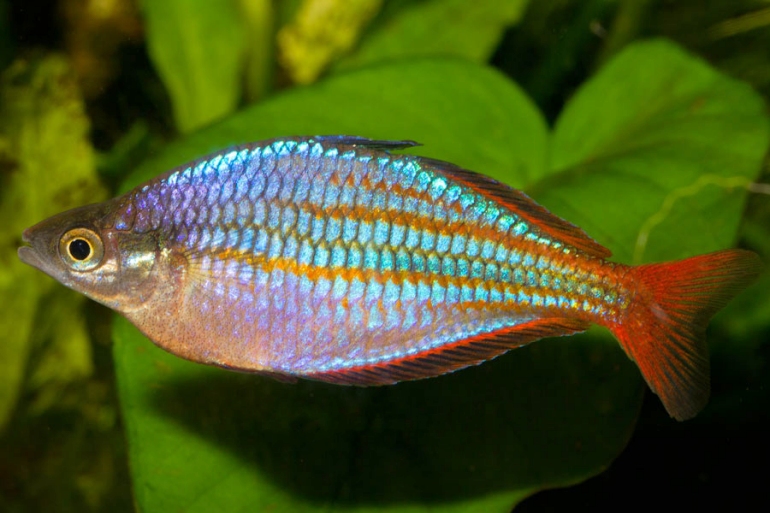|
 |
Melanotaenia rubrivittata (male) - photo© Gary Lange |
Allen, Unmack & Hadiaty, 2015
Laser Red Rainbowfish
Species Summary
Males head greyish dorsally, silvery blue on cheek and operculum; brilliant neon blue on upper two-thirds of body with five red stripes; ventral portion of head and body silvery white to blue with slight pinkish hue; first dorsal fin blue; second dorsal fin blue with red basal stripe and broad red zone encompassing outer margin and posterior portion of fin; anal fin bluish with red basal stripe and red outer margin; caudal fin red, grading to bluish or translucent along posterior margin; pelvic fins bluish to translucent with red anterior margin and reddish posterior tip; pectoral fins translucent. Nuptial males are capable of "switching on" a golden-orange mid-dorsal stripe, extending from the dorsal-fin origin to the snout tip. Colour pattern of freshly captured females generally similar to that of males except overall pattern is much duller and lacks brilliant red markings on fins; second dorsal and anal fins with blue outer margin.
Melanotaenia rubrivittata is most similar in appearance to Melanotaenia praecox from the Mamberamo River system, lying approximately 100 km to the east. The two species share a number of similarities including a neon-blue ground colour, brilliant red markings on the median fins, relatively small maximum size (less than about 50 mm SL), overlapping counts for dorsal rays, anal rays, pectoral rays, predorsal scales, and cheek scales, and most morphometric proportions. Genetic results reveal the two species are clearly separable. In addition, M. praecox lacks the characteristic red body stripes of male M. rubrivittata. The males of M. praecox also tend to be deeper bodied than males of M. rubrivittata. There is also a slight difference in snout length with M. praecox generally having a shorter snout than M. rubrivittata. Lastly, M. praecox has fewer lateral scales (usually 29-30 versus 32-33) and frequently has 11 transverse scales (always 10 in M. rubrivittata).
The species is named rubrivittata (Latin: red-stripes) with reference to the distinctive markings that distinguish it from the similar appearing M. praecox.
Distribution & Habitat
Melanotaenia rubrivittata is known only from the Wapoga River system in the vicinity of Siewa, former site of a Freeport Mining Company exploration camp. This location is approximately 100 km northeast of Nabire, a relatively large town lying on the edge of Cenderawasih Bay. The type locality is situated about 130 km upstream in the Wapoga system at an elevation of approximately 70 m on the edge of a broad floodplain adjacent to nearby foothills. At the time of collection (April 1998) it consisted of a small pond, resulting from previous flooding of the nearby Tirawiwa (sometimes spelt Tiawiwa) River. The pond was fully shaded and about 12 m in diameter with an average depth of only 30 cm. The substratum was composed of soft mud covered with a layer of organic debris, mainly dead leaves. Additional paratypes were collected in a small (2-5 m width), closed-canopy rainforest stream 1.3 km northwest from the type locality. Melanotaenia rubrivittata and Mogurnda wapoga were the only fishes collected at both sites, although a few juvenile Glossolepis leggetti were obtained from the pond habitat. Temperature and pH values of 27°C/6.6 and 28.7°C/8.0 were recorded for the respective pond and stream habitats. Specimens obtained for genetic analysis in 2012 from the same general area were found in a small (about 1. 5-2 m wide) rainforest stream that was also inhabited by Melanotaenia rubripinnis and Chilatherina alleni. The Wapoga system is an important location for freshwater fish endemism with all the previously mentioned melanotaeniids known thus far only from this region, except C. alleni, which ranges to the Siriwo River drainage, approximately 70 km to the southwest. In addition, Mogurnda wapoga and Sicyopterus erythropterus are known only from this area.
Literature
Allen G.R. & S. Renyaan (2000) Fishes of the Wapoga River System. In: Mack A.L. and L.E. Alonso (eds.) A Biological Assessment of the Wapoga River Area of Northwestern West Papua, Indonesia. RAP Bulletin of Biological Assessment 14, Conservation International, Washington, DC. USA.
Allen G.R., P.J. Unmack and R.K. Hadiaty (2015) Melanotaenia rubrivittata, A New Species of Rainbowfish (Melanotaeniidae) from Northwestern Papua Province, Indonesia. Fishes of Sahul 29(1): 846-859.
Adrian R. Tappin
June, 2015



|
|

